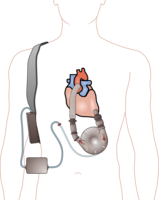
Photo from wikipedia
Purpose Despite the recent advances in Left Ventricular Assist Device (LVAD) therapy, stroke remains a frequent and catastrophic complication. Hypertension (HTN) after LVAD implant has been associated with an increased… Click to show full abstract
Purpose Despite the recent advances in Left Ventricular Assist Device (LVAD) therapy, stroke remains a frequent and catastrophic complication. Hypertension (HTN) after LVAD implant has been associated with an increased risk of stroke, but the association between HTN before LVAD implant and stroke has never been studied. We hypothesized that LVAD patients with elevated blood pressure (BP) during outpatient visits before the LVAD implant may have an increased risk of stroke. Methods We retrospectively identified 175 patients on HeartMate II or HeartMate 3 LVAD support (age 54.3±13.1 y, 77% male, 35% ischemic etiology, 32% HeartMate 3) who had at least one outpatient BP measurement with a regular BP cuff in the 2 years preceding the LVAD implant. Average pre-implant BP was calculated based on outpatient visits. Stroke was defined based on clinical and radiographic evidence. Patients who had any event (death, stroke, device exchange, pump thrombosis, heart transplant) in the first 30 days post-implant were excluded. Results 17 patients (9.7%) had a stroke. Average pre-implant SBP was significantly higher in the patients who had a stroke after LVAD implant (105±13 vs 116±13 mmHg, p Conclusion High SBP in the years before LVAD implant is associated with an increased risk of post-implant stroke. Further studies are necessary to establish if high SBP before the implant may represent an early sign of vascular dysfunction that eventually leads to stroke.
Journal Title: Journal of Heart and Lung Transplantation
Year Published: 2021
Link to full text (if available)
Share on Social Media: Sign Up to like & get
recommendations!